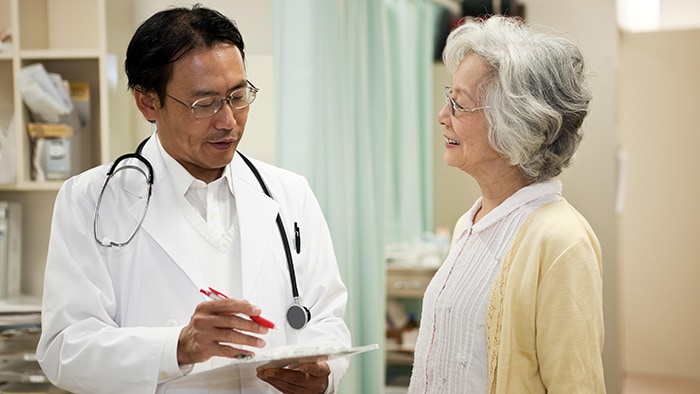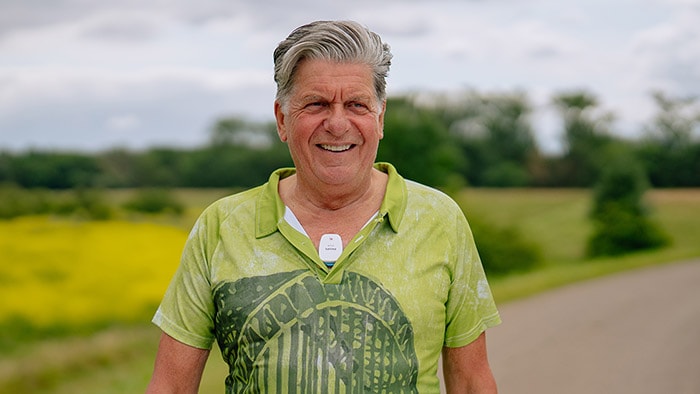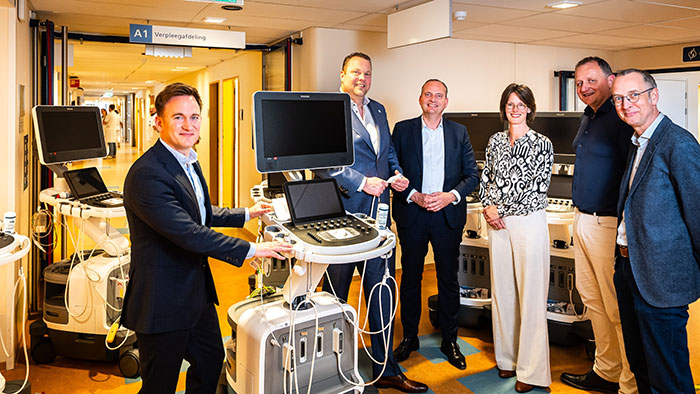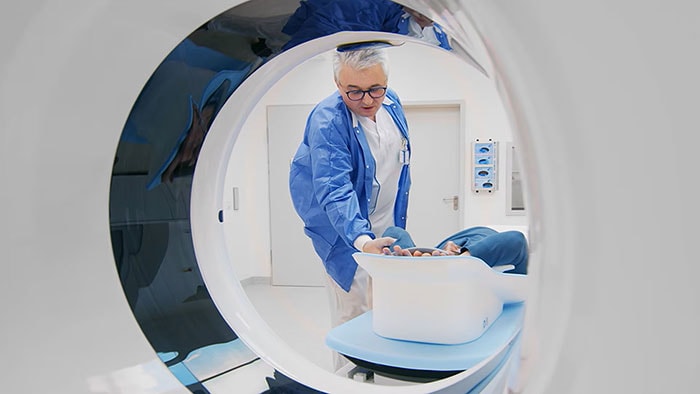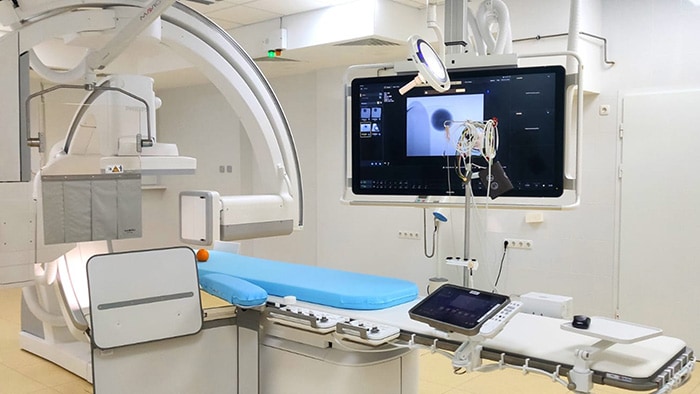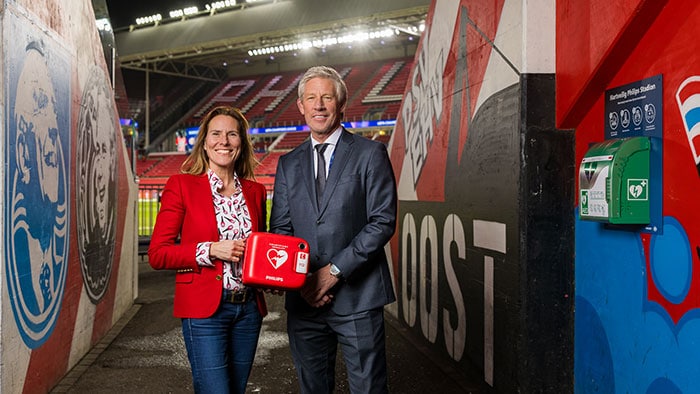Hoe de dialoog tussen een ingenieur, onderzoeker en arts innovatie versnelt
aug 07, 2024 | 4 minuten leestijd
Eén op de vier jongvolwassenen in Nederland heeft slaapproblemen, zo blijkt uit onderzoek van het Centraal Bureau van de Statistiek in 2022. Het is dan ook niet verwonderlijk dat miljoenen mensen wereldwijd slaap trackers en apps gebruiken om hun slaap te monitoren, in de hoop hun slaapgewoonten te verbeteren. Ingenieurs, onderzoekers en artsen werken in de Brainport regio samen aan innovaties om slaapstructuur beter te kunnen monitoren. Wat is cruciaal om dergelijke innovaties succesvol te maken?
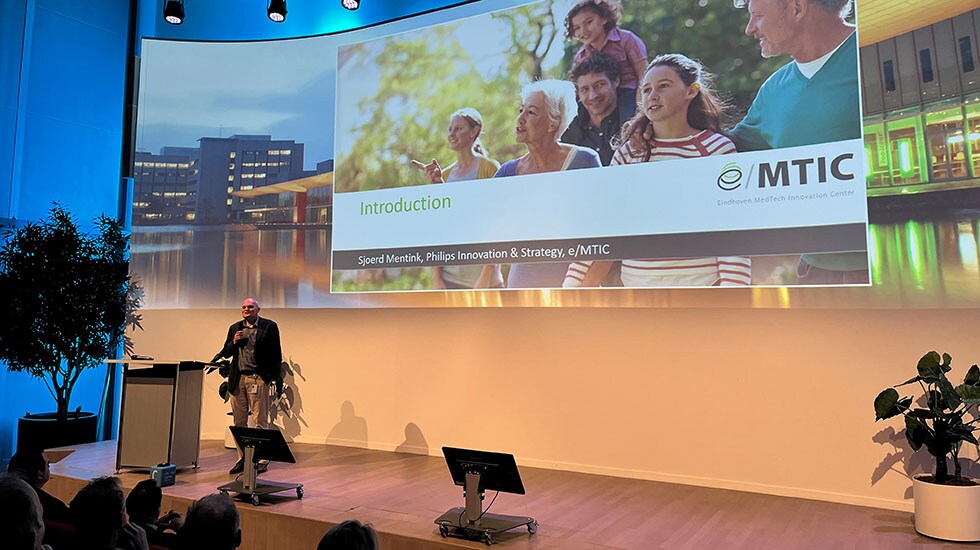
Bij het Eindhoven MedTech Innovation Center (e/MTIC) is het antwoord op die vraag duidelijk: met elkaar in gesprek blijven vanuit verschillende expertises helpt innovatie te versnellen. Tijdens de Open Lecture van de TU/e aan de High Tech Campus gingen diverse sprekers in op het voordeel van samenwerken. De aanwezigen hoorden hoe verschillende vakgebieden bijdroegen aan de techniek achter accurate slaapmonitoring en aan de manier waarop rupturen in bloedvaten beter voorspeld kunnen worden.
Dialoog tussen wetenschap, technologie en ziekenhuizen
Pedro Fonseca, Senior Researcher bij Philips, en Merel van Gilst, Assistant Professor aan de Technische Universiteit Eindhoven, beklommen als eerste het podium en gaven een presentatie over de dialoog tussen wetenschap, technologie en ziekenhuizen aan de hand van een praktijkvoorbeeld. Zij ontwikkelden samen met Epilepsie- en Slaapcentrum Kempenhaeghe, een oplossing voor nauwkeurige slaapmonitoring thuis, waarbij een nieuwe klinische dataset wordt gecombineerd met geavanceerde machine learning technologie.
Nauwkeurigheid van slaap apps
Want hoewel veel mensen gebruik maken van slaaptrackers en apps zijn de resultaten daarvan niet altijd heel betrouwbaar. Deze apps maken gebruik van draagbare sensoren die verschillende fysiologische processen meten, zoals hartritme of ademhaling, meestal bij gezonde, jonge volwassenen. In de praktijk blijkt het moeilijk om deze gegevens nauwkeurig te koppelen aan de verschillende slaapstadia om de slaapstructuur van patiënten met slaapstoornissen betrouwbaar te analyseren.
Gouden standaard voor slaapmonitoring niet geschikt voor langdurige thuismonitoring
Een betrouwbaar beeld van de slaapstructuur kan worden gemaakt met de zogenaamde polysomnografie (PSG). Hierbij wordt de patiënt gedurende de nacht gecontroleerd op verschillende parameters, waaronder hersenactiviteit, oogbewegingen en spieractiviteit. Dit vereist echter in veel gevallen een klinische beoordeling in een slaapcentrum, waar verschillende, opdringerige sensoren worden gebruikt om de persoon te monitoren. Deze oplossing is daarom niet geschikt voor langdurige monitoring thuis.
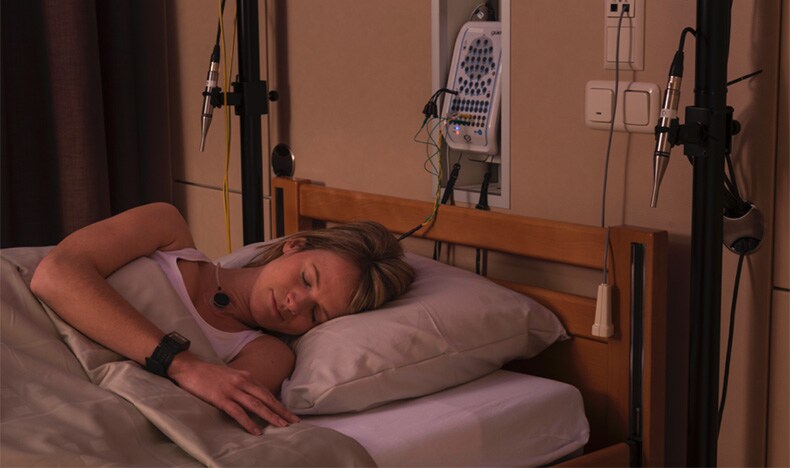
Algoritme op basis van hartritme
Op basis van de SOMNIA dataset, ontwikkeld door het Kempenhaeghe Centrum voor Slaapgeneeskunde in samenwerking met de TU/e en Philips en gebaseerd op gegevens van meer dan 2.000 deelnemers, konden onderzoekers van Philips een algoritme ontwikkelen dat nauwkeurig slaapstadia kan bepalen op basis van subtiele veranderingen in de hartslag gedurende de nacht. “Dit stelt ons ook in staat om de patiënt thuis te monitoren, gedurende een langere periode. Dit geeft ons meer informatie over bijvoorbeeld het effect van een behandeling voor een slaapstoornis, of de variaties in slaapstructuur tussen nachten”, aldus Pedro Fonseca.
Scheuren van bloedvat voorspellen
De tweede podiumsessie tijdens de Open Lecture ging dieper in op het voorspellen van scheuren in bloedvaten. Marc van Sambeek, vaatchirurg in het Catharina Ziekenhuis, vroeg aan Richard Lopata, hoogleraar en onderzoeker aan de TU/e, of hij een technologie kan ontwikkelen om rupturen in bloedvaten beter te kunnen voorspellen. Zij gingen op het podium met elkaar in gesprek om te laten zien hoe zij gebruik kunnen maken van elkaars expertises bij ogenschijnlijk uitdagende vraagstukken.
Patiënten met een verwijding in de buikslagader, een abdominaal aorta-aneurysma (AAA), lopen het risico dat het bloedvat scheurt; in sommige gevallen kunnen patiënten hieraan overlijden. Wereldwijd is deze aandoening de elfde doodsoorzaak. Het is daarom belangrijk om de patiënt te blijven controleren nadat de verwijding is vastgesteld. Als de verwijding te groot wordt, komt de patiënt in aanmerking voor een operatie. De grootte van het aneurysma is echter niet altijd voor elke patiënt voldoende indicatie van het risico op een ruptuur. Naast de grootte van de verwijding spelen mogelijk andere factoren een rol, zoals hoe de verwijding zich in de loop van de tijd ontwikkelt of wat de structuur is.
Richard wilde graag een oplossing vinden voor Marc, maar zijn de oplossingen acceptabel voor klinisch gebruik? Er volgde een dialoog tussen de vaatchirurg en de onderzoeker om een antwoord te vinden op Marcs vraag.
Samenvattend heeft Richard een nieuwe ultrasone beeldvormingstechniek ontwikkeld, die zijn weg heeft gevonden naar de kliniek en momenteel bij honderden patiënten wordt getest. De technologie is klinisch gevalideerd. De beeldvorming is beduidend beter en er zijn modellen ontwikkeld die het risico op ruptuur en groei van de arteriële wand kunnen voorspellen. Marc is enthousiast, maar hoopt dat de technologie uiteindelijk geïmplementeerd kan worden in commerciële platformen voor sneller en eenvoudiger gebruik.
Voor het publiek is het duidelijk: deze dialoog zorgt voor een snelle afstemming en betere innovaties, die in de klinische praktijk gebruikt kunnen worden.
Eindhoven MedTech Innovatie Centrum (e/MTIC)
Om zorginnovatie in de Brainport regio te versnellen is in 2018 het Eindhoven MedTech Innovation Center (e/MTIC) opgericht, een strategische samenwerking tussen het Catharina Ziekenhuis, Máxima Medisch Centrum, Epilepsie- en Slaapcentrum Kempenhaeghe, Technische Universiteit Eindhoven (TU/e) en Philips. Sinds de oprichting hebben startups en andere organisaties zich aangesloten bij het ecosysteem en zijn de eerste impactvolle resultaten aangetoond in cardiovasculaire, perinatale en slaapgeneeskunde.
How the dialogue between an engineer, researcher and doctor, accelerates innovation
One in four young adults in the Netherlands has sleeping problems, according to research by Statistics Netherlands in 2022. It's not surprising, then, that millions of people worldwide use sleep trackers and apps to monitor their sleep, hoping to improve their sleep habits. Engineers, researchers and doctors are working together in the Brainport region on innovations to better monitor sleep structure. What is crucial to make such innovations successful?
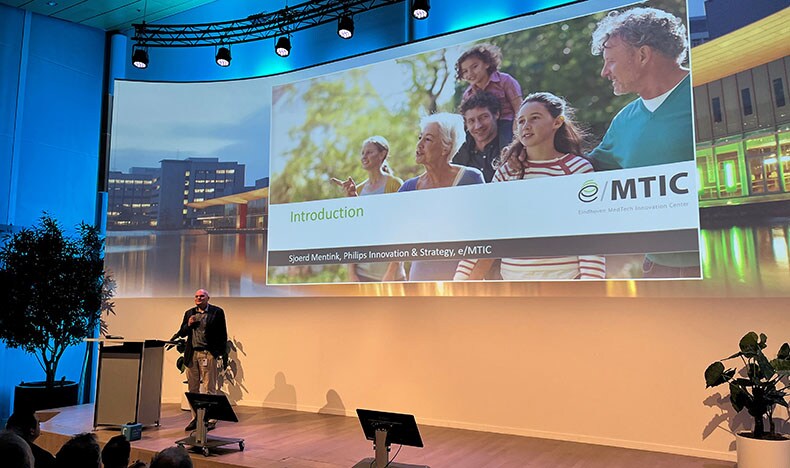
At the Eindhoven MedTech Innovation Center (e/MTIC), the answer to that question is clear: continuing to talk to each other from different areas of expertise helps to accelerate innovation. During TU/e's Open Lecture at the High Tech Campus, various speakers discussed the benefits of collaboration. The attendees heard how various fields of expertise contributed to the technology behind accurate sleep monitoring and to the way in which ruptures in blood vessels can be better predicted.
Dialogue between science, technology and hospitals
Pedro Fonseca, Senior Researcher at Philips, and Merel van Gilst, Assistant Professor at Eindhoven University of Technology, were the first to take the stage and gave a presentation on the dialogue between science, technology and hospitals based on a practical example. Together with Epilepsy and Sleep Center Kempenhaeghe, they developed a solution for accurate sleep monitoring at home, combining a new clinical dataset with advanced machine learning technology.
Accuracy of sleep apps
Although many people use sleep trackers and apps, the results are not always very reliable. These apps use wearable sensors that measure various physiological processes, such as heart rate or respiration, usually in healthy, young adults. In practice, it is difficult to accurately link these data to the different sleep stages in order to reliably analyze the sleep structure of patients with sleep disorders.
Gold standard for sleep monitoring not suitable for long-term home monitoring
A reliable picture of the sleep structure can be made with the so-called polysomnography (PSG). This involves monitoring the patient throughout the night for various parameters, including brain activity, eye movements, and muscle activity. However, in many cases, this requires a clinical assessment in a sleep center, where various, intrusive sensors are used to monitor the person. This solution is therefore not suitable for long-term monitoring at home.

Algorithm based on heart rhythm
Based on the SOMNIA dataset, developed by the Kempenhaeghe Center for Sleep Medicine in collaboration with TU/e and Philips and based on data from more than 2,000 participants, Philips researchers were able to develop an algorithm that can accurately determine sleep stages based on subtle changes in heart rate throughout the night. "This also allows us to monitor the patient at home, over a longer period of time. This gives us more information about, for example, the effect of a treatment for a sleep disorder, or the variations in sleep structure between nights," says Pedro Fonseca.
Predicting rupture of blood vessels
The second podium session during the Open Lecture took a closer look at predicting rupture in blood vessels. Marc van Sambeek, vascular surgeon at the Catharina Hospital, asked Richard Lopata, professor and researcher at TU/e, if he could develop a technology to better predict ruptures in blood vessels. They talked to each other on stage to show how they can make use of each other's expertise on seemingly challenging issues.
Patients with abdominal artery dilatation, abdominal aortic aneurysm (AAA), are at risk of blood vessel rupture; in some cases, patients may die from this. The condition is the 11th cause of death worldwide. It is therefore important to continue monitoring the patient after the dilatation has been established. If the dilatation becomes too large, the patient is a candidate for surgery. However, the size of the aneurysm is not always a sufficient indication of the risk of rupture for every patient. In addition to the size of the dilatation, other factors may play a role, such as how the dilatation develops over time or what its structure is.
Richard was keen to find a solution for Marc, but are the solutions acceptable for clinical use? A dialogue ensued between the vascular surgeon and the researcher to find an answer to Marc's question.
In summary, Richard has developed a new ultrasound imaging technique, which has made its way into the clinic and is currently tested in hundreds of patients. Currently, the technology is clinically validated. The imaging is significantly better, and models have been developed that can predict the risk of rupture and growth of the arterial wall. Marc is enthusiastic but hopes that in the end the technology can be implemented in commercial platforms for faster and easier use. For the audience, it is clear: this dialogue ensures fast alignment and better outcomes that can be used in practice.
For the public, it is clear: this dialogue ensures rapid coordination and better innovations, which can be used in clinical practice.
Eindhoven MedTech Innovation Centre (e/MTIC)
To accelerate healthcare innovation in the Brainport region, the Eindhoven MedTech Innovation Center (e/MTIC) was established in 2018, a strategic collaboration between the Catharina Hospital, Máxima Medical Center, Epilepsy and Sleep Center Kempenhaeghe, Eindhoven University of Technology (TU/e) and Philips. Since its inception, startups and other organizations have joined the ecosystem and the first impactful results have been demonstrated in cardiovascular, perinatal, and sleep medicine.
